Determination of Transformer Oil Contamination from the OLTC Gases in the Power Transformers of a Distribution System Operator
Abstract
1. Introduction
2. Background Theory
3. Study Characteristics
4. Machine Learning Methodology
4.1. Data Preprocessing
4.2. Calculation of Output Variables
4.3. Algorithm Development
- 1.
- Calculate the impurity of node t.
- 2.
- Calculate the probability at node t.
- 3.
- Sort predictor elements in ascending order.
- 4.
- Calculate the impurity gain ().
- 5.
- Selection of splitting node.
- 6.
- Once the splitting node has been selected, the child nodes ( and ) become parent nodes (node t). Then, the previous steps are recursively repeated to split the new parent nodes until pure nodes are achieved or the stopping rules are reached.
- The maximum number of decision splits was 50.
- The minimum number of branch node observations was 10.
- The minimum number of leaf node observations was one.
4.4. Algorithm Training and Validation
4.5. Construct the DT
5. Conclusions
Author Contributions
Funding
Acknowledgments
Conflicts of Interest
Abbreviations
| CH | Methane |
| CH | Acetylene |
| CH | Ethylene |
| CH | Ethane |
| D1 | Discharges of low energy |
| D2 | Discharges of high energy |
| DGA | Dissolved gas analysis |
| DPM | Duval pentagon method |
| DSO | Distribution system operator |
| DT | Decision tree |
| DTM | Duval triangle method |
| EK | Expert knowledge |
| FDS | Frequency domain spectroscopy |
| FFA | Furfuraldehyde |
| H | Hydrogen |
| HI | Health index |
| ML | Machine learning |
| OLTC | On-load tap-changer |
| OQA | Oil quality analysis |
| PD | Partial discharges |
| PDC | Polarisation and depolarisation current |
| T1 | Thermal faults (<300 C) |
| T2 | Thermal faults (300–700 C) |
| T3 | Thermal faults (>700 C) |
References
- Wu, X.; He, Y.; Duan, J. A Deep Parallel Diagnostic Method for Transformer Dissolved Gas Analysis. Appl. Sci. 2020, 10, 1329. [Google Scholar] [CrossRef]
- Bohatyrewicz, P.; Płowucha, J.; Subocz, J. Condition Assessment of Power Transformers Based on Health Index Value. Appl. Sci. 2019, 9, 4877. [Google Scholar] [CrossRef]
- CIGRE. Ageing High Voltage Substation Equipment and Possible Mitigation Techniques; WG A3.29. Technical Brochure No. 725; CIGRE: Paris, France, 2018. [Google Scholar]
- Azmi, A.; Jasni, J.; Azis, N.; Kadir, M.A. Evolution of transformer health index in the form of mathematical equation. Renew. Sustain. Energy Rev. 2017, 76, 687–700. [Google Scholar] [CrossRef]
- CIGRE. Advances in DGA Interpretation; JWG D1/A2.47. Technical Brochure No. 771; CIGRE: Paris, France, 2019. [Google Scholar]
- IEEE. IEEE Guide for the Interpretation of Gases Generated in Mineral Oil-Immersed Transformers; IEEE Std C57.104-2019 (Revision of IEEE Std C57.104-2008); IEEE: Piscataway, NJ, USA, 2019; pp. 1–98. [Google Scholar] [CrossRef]
- IEC. Mineral Oil-Filled Electrical Equipment in Service—Guidance on the Interpretation of Dissolved and Free Gases Analysis; IEC 60599 ed.3.0; IEC: Geneva, Switzerland, 2015. [Google Scholar]
- Frotscher, R. Common oil expansion tank for transformers and tap-changers. Transform. Mag. 2017, 4, 20–25. [Google Scholar]
- N’cho, J.; Fofana, I.; Hadjadj, Y.; Beroual, A. Review of Physicochemical-Based Diagnostic Techniques for Assessing Insulation Condition in Aged Transformers. Energies 2016, 9, 367. [Google Scholar] [CrossRef]
- Duval, M.; dePabla, A. Interpretation of gas-in-oil analysis using new IEC publication 60599 and IEC TC 10 databases. IEEE Electr. Insul. Mag. 2001, 17, 31–41. [Google Scholar] [CrossRef]
- Mollmann, A.; Pahlavanpour, B. New guidelines for interpretation of dissolved gas analysis in oil-filled transformers. Electra 1999, 186, 31–51. [Google Scholar]
- Samsudin, R.; Ramli, A.Q.; Berhanuddin, A.; Zaidey, Y. Field experience of transformer untanking to identify electrical faults and comparison with Dissolved Gas Analysis. In Proceedings of the 2009 3rd International Conference on Energy and Environment (ICEE), Malacca, Malaysia, 7–8 December 2009; pp. 299–305. [Google Scholar] [CrossRef]
- Jadav, R.B.; Saha, T.K.; Ekanayake, C. Transformer diagnostics using dissolved gas analysis and polarisation and depolarisation current measurements—A case study. In Proceedings of the AUPEC 2011, Brisbane, Australia, 25–28 September 2011; pp. 1–6. [Google Scholar]
- Istad, M.K.; Foros, J.; Tveten, E.G.; Kolstad, M.L.; Solvang, E.; Rosenlund, G.H.; Hagner, S.; Henderson, M.G.; Coullon, J.L. Use Case Testing—SAMBA WP5 Report; Technical Report; SINTEF Rapport: Trondheim, Norway, 2019. [Google Scholar]
- Werle, P.; Radigk, C.; Sorgatz, W.; Hahn, M.; Wasserberg, V. Comparison of Different DGA (Dissolved Gas Analysis) Methods for the Condition Assessment of Power Transformers. In Proceedings of the International Conference Large Power Transformers-Modern Trends in Application, Operation & Maintenance, New Delhi, India, 12–13 October 2006. [Google Scholar]
- Alqudsi, A.; El-Hag, A. Application of Machine Learning in Transformer Health Index Prediction. Energies 2019, 12, 2694. [Google Scholar] [CrossRef]
- Qi, B.; Zhang, P.; Rong, Z.; Wang, J.; Li, C.; Chen, J. Rapid Transformer Health State Recognition Through Canopy Cluster-Merging of Dissolved Gas Data in High-Dimensional Space. IEEE Access 2019, 7, 94520–94532. [Google Scholar] [CrossRef]
- Kadim, E.; Azis, N.; Jasni, J.; Ahmad, S.; Talib, M. Transformers Health Index Assessment Based on Neural-Fuzzy Network. Energies 2018, 11, 710. [Google Scholar] [CrossRef]
- Liu, Y.; Song, B.; Wang, L.; Gao, J.; Xu, R. Power Transformer Fault Diagnosis Based on Dissolved Gas Analysis by Correlation Coefficient-DBSCAN. Appl. Sci. 2020, 10, 4440. [Google Scholar] [CrossRef]
- Benhmed, K.; Shaban, K.B.; El-Hag, A. Cost effective assessment of transformers using machine learning approach. In Proceedings of the 2014 IEEE Innovative Smart Grid Technologies—Asia (ISGT ASIA), Kuala Lumpur, Malaysia, 20–23 May 2014; pp. 328–332. [Google Scholar] [CrossRef]
- Ashkezari, A.D.; Ma, H.; Saha, T.K.; Ekanayake, C. Application of fuzzy support vector machine for determining the health index of the insulation system of in-service power transformers. IEEE Trans. Dielectr. Electr. Insul. 2013, 20, 965–973. [Google Scholar] [CrossRef]
- Akhavanhejazi, M.; Gharehpetian, G.; Faraji-dana, R.; Moradi, G.; Mohammadi, M.; Alehoseini, H. A new on-line monitoring method of transformer winding axial displacement based on measurement of scattering parameters and decision tree. Expert Syst. Appl. 2011, 38, 8886–8893. [Google Scholar] [CrossRef]
- Guo, C.; Dong, M.; Wu, Z. Fault Diagnosis of Power Transformers Based on Comprehensive Machine Learning of Dissolved Gas Analysis. In Proceedings of the 2019 IEEE 20th International Conference on Dielectric Liquids (ICDL), Roma, Italy, 23–27 June 2019; pp. 1–4. [Google Scholar] [CrossRef]
- Huang, X.; Wang, X.; Tian, Y. Research on Transformer Fault Diagnosis Method based on GWO Optimized Hybrid Kernel Extreme Learning Machine. In Proceedings of the 2018 Condition Monitoring and Diagnosis (CMD), Perth, Australia, 23–26 September 2018; pp. 1–5. [Google Scholar] [CrossRef]
- Han, Y.; Zhao, D.; Hou, H. Oil-immersed Transformer Internal Thermoelectric Potential Fault Diagnosis Based on Decision-tree of KNIME Platform. Procedia Comput. Sci. 2016, 83, 1321–1326. [Google Scholar] [CrossRef]
- Samantaray, S.; Dash, P. Decision Tree based discrimination between inrush currents and internal faults in power transformer. Int. J. Electr. Power Energy Syst. 2011, 33, 1043–1048. [Google Scholar] [CrossRef]
- Fei, S.-W.; Zhang, X.-B. Fault diagnosis of power transformer based on support vector machine with genetic algorithm. Expert Syst. Appl. 2009, 36, 11352–11357. [Google Scholar] [CrossRef]
- Ganyun, L.; Haozhong, C.; Haibao, Z.; Lixin, D. Fault diagnosis of power transformer based on multi-layer SVM classifier. Electr. Power Syst. Res. 2005, 74, 1–7. [Google Scholar] [CrossRef]
- CIGRE. Condition Assessment of Power Transformers; WG A2.49. Technical Brochure No. 761; CIGRE: Paris, France, 2019. [Google Scholar]
- CIGRE. DGA in Non-Mineral Oils and Load Tap Changers and Improved DGA Diagnosis Criteria; WG D1.32. Technical Brochure No. 443; CIGRE: Paris, France, 2010. [Google Scholar]
- IEEE. IEEE Guide for Dissolved Gas Analysis in Transformer Load Tap Changers; IEEE Std C57.139-2015 (Revision of IEEE Std C57.139-2010); IEEE: Piscataway, NJ, USA, 2016; pp. 1–45. [Google Scholar] [CrossRef]
- IEC. Tap-Changers—Part 2: Application Guide; IEC 60214-2 ed.1.0; IEC: Geneva, Switzerland, 2004. [Google Scholar]
- Frotscher, R. Hermetical sealing of transformers and tap-changers. Transform. Mag. 2017, 4, 24–29. [Google Scholar]
- Duval, M. The duval triangle for load tap changers, non-mineral oils and low temperature faults in transformers. IEEE Electr. Insul. Mag. 2008, 24, 22–29. [Google Scholar] [CrossRef]
- MATLAB. version 9.5.0.1033004 (R2018b); The MathWorks Inc.: Natick, MA, USA, 2019. [Google Scholar]
- Breiman, L.; Friedman, J.H.; Olshen, R.A.; Stone, C.J. Classification and Regression Trees; Wadsworth and Brooks: Monterey, CA, USA, 1984. [Google Scholar]
- Coppersmith, D.; Hong, S.J.; Hosking, J.R.M. Partitioning Nominal Attributes in Decision Trees. Data Min. Knowl. Discov. 1999, 3, 197–217. [Google Scholar] [CrossRef]
- Bustamante, S.; Manana, M.; Arroyo, A.; Martinez, R.; Laso, A. Developed Algorithms—Transformer oil contamination from the OLTC gases. Mendeley Data 2020. [Google Scholar] [CrossRef]
- Bustamante, S.; Manana, M.; Arroyo, A.; Martinez, R.; González, A.; Rodríguez, J.I. Case Study—Calculation of DGA Limit Values and Sampling Interval in Power Transformers. In Proceedings of the 2019 6th International Advanced Research Workshop on Transformers (ARWtr), Cordoba, Spain, 7–9 October 2019; pp. 64–68. [Google Scholar] [CrossRef]
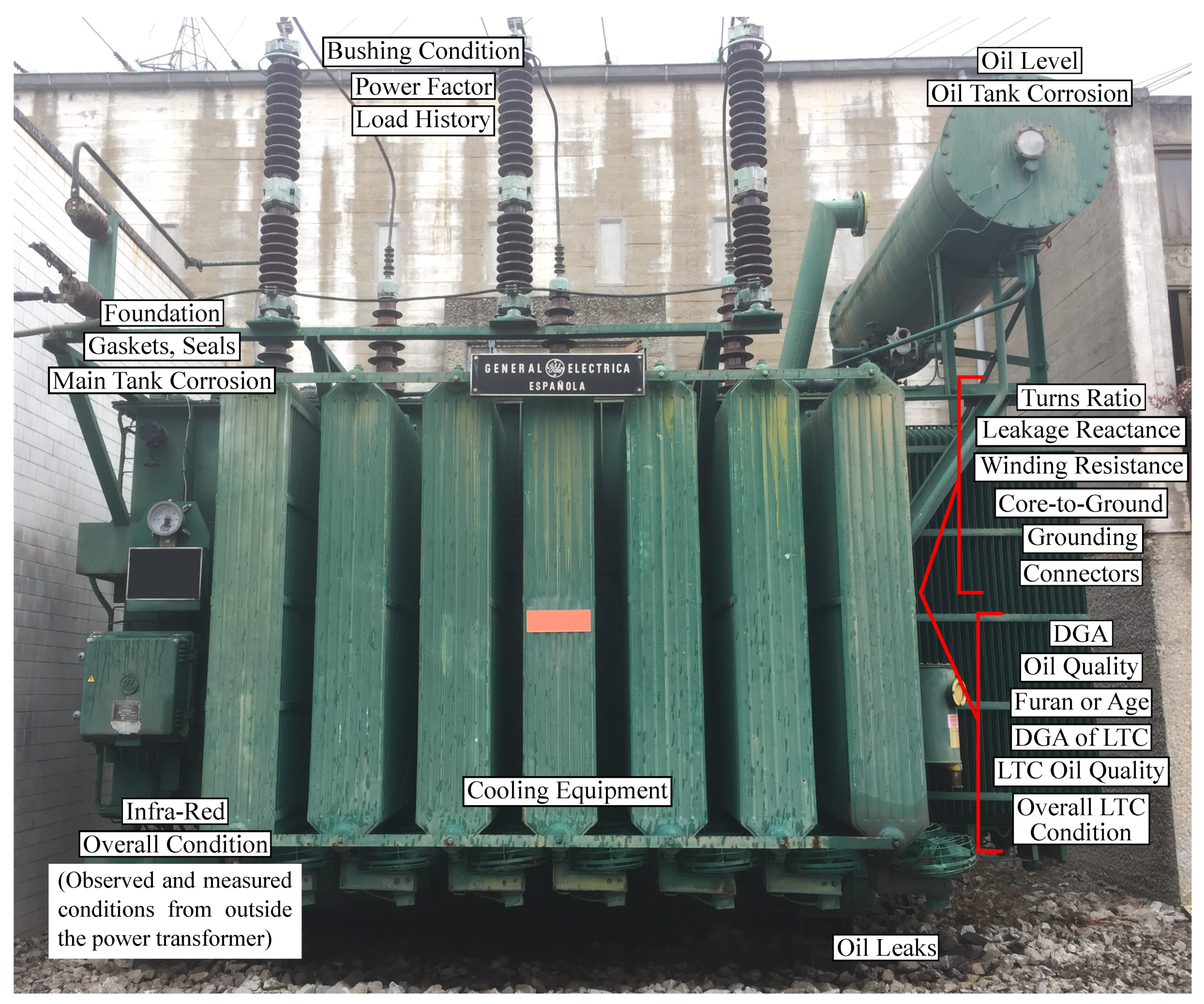
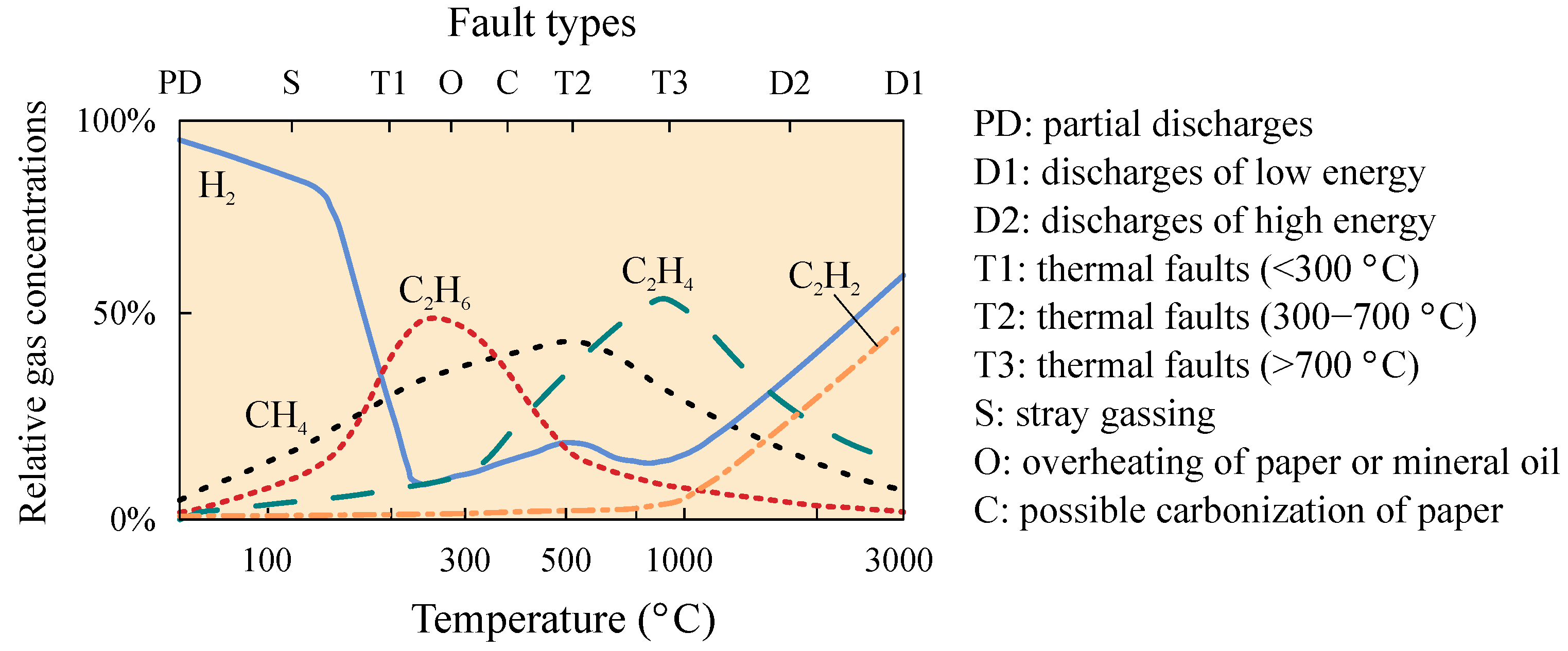
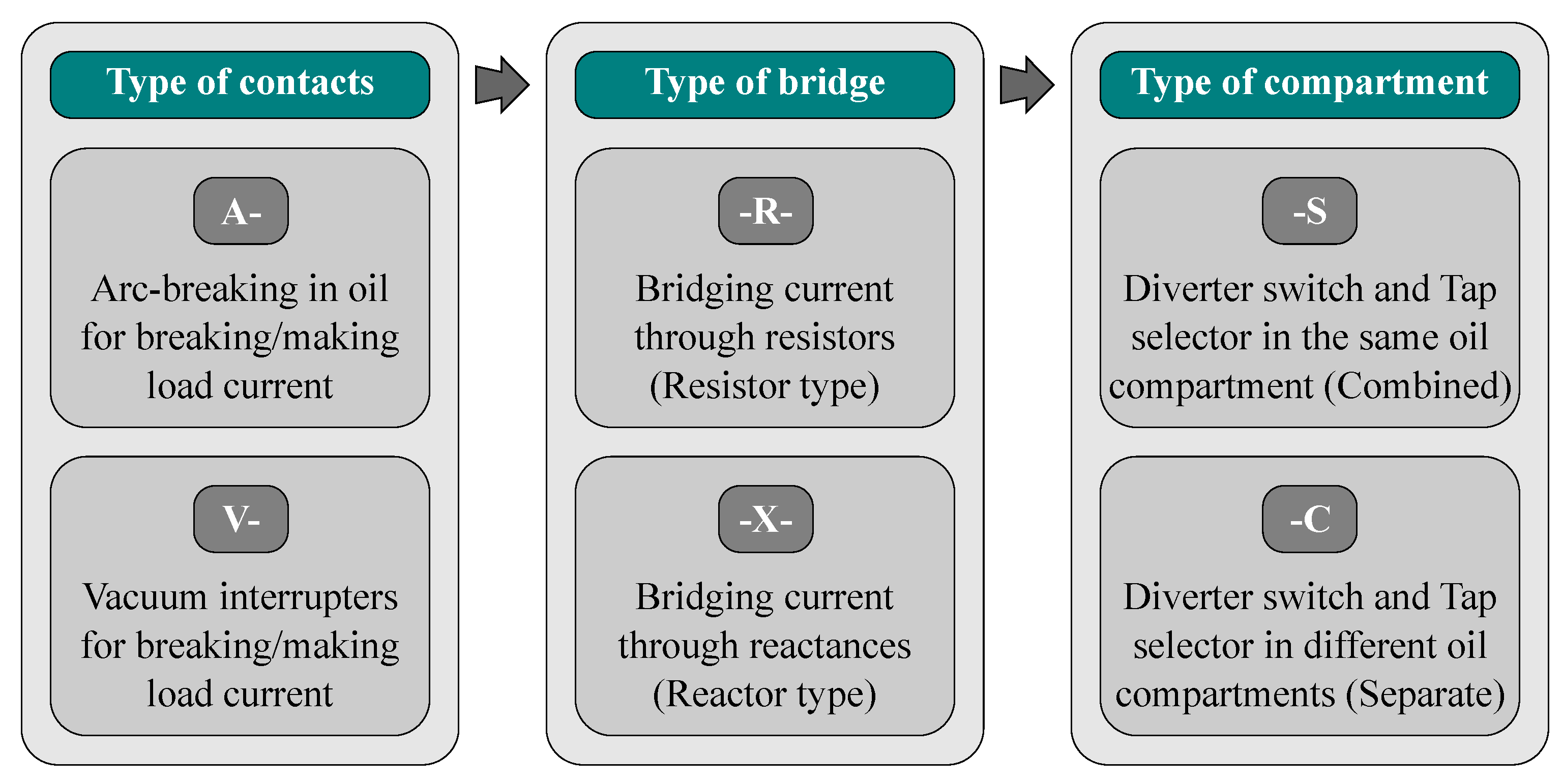
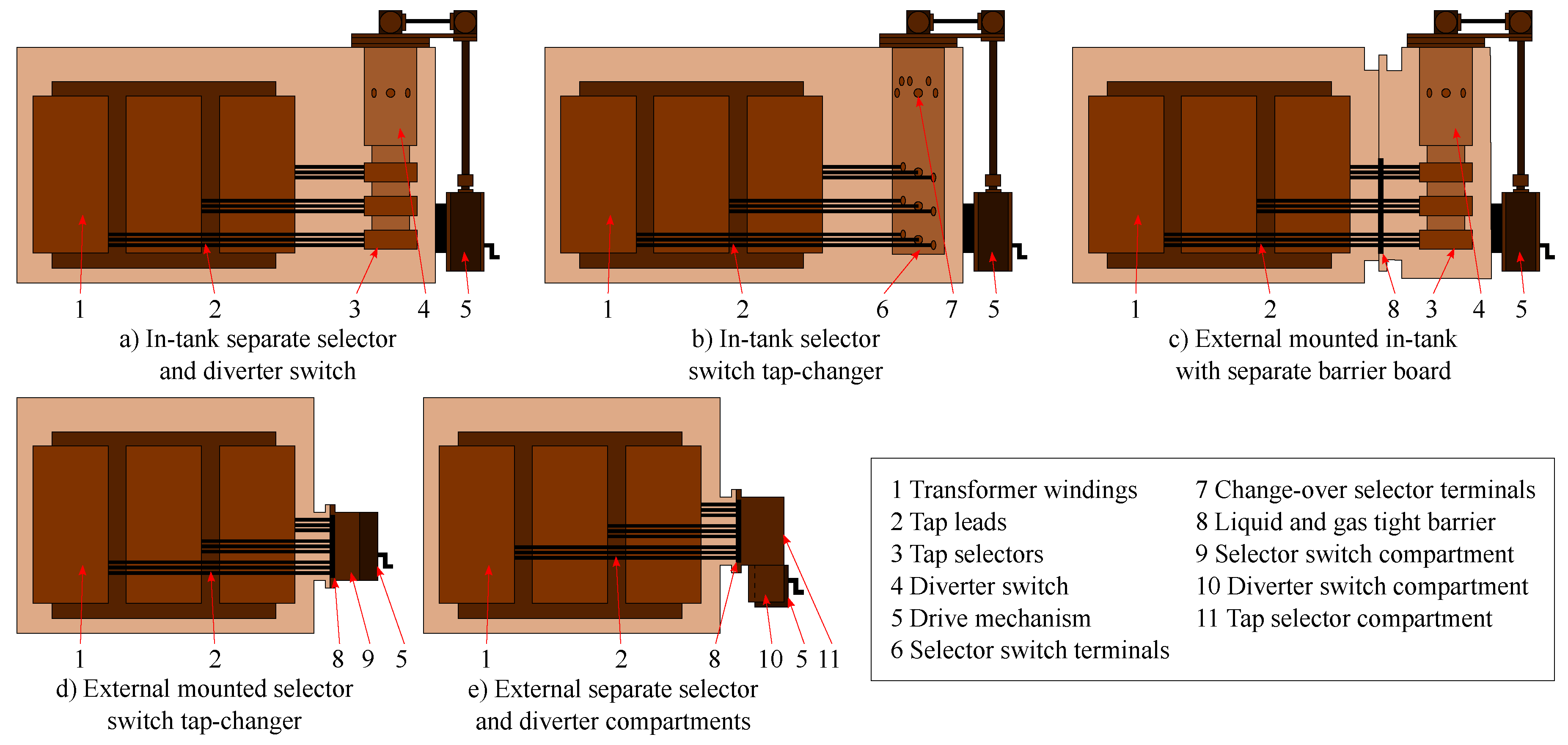
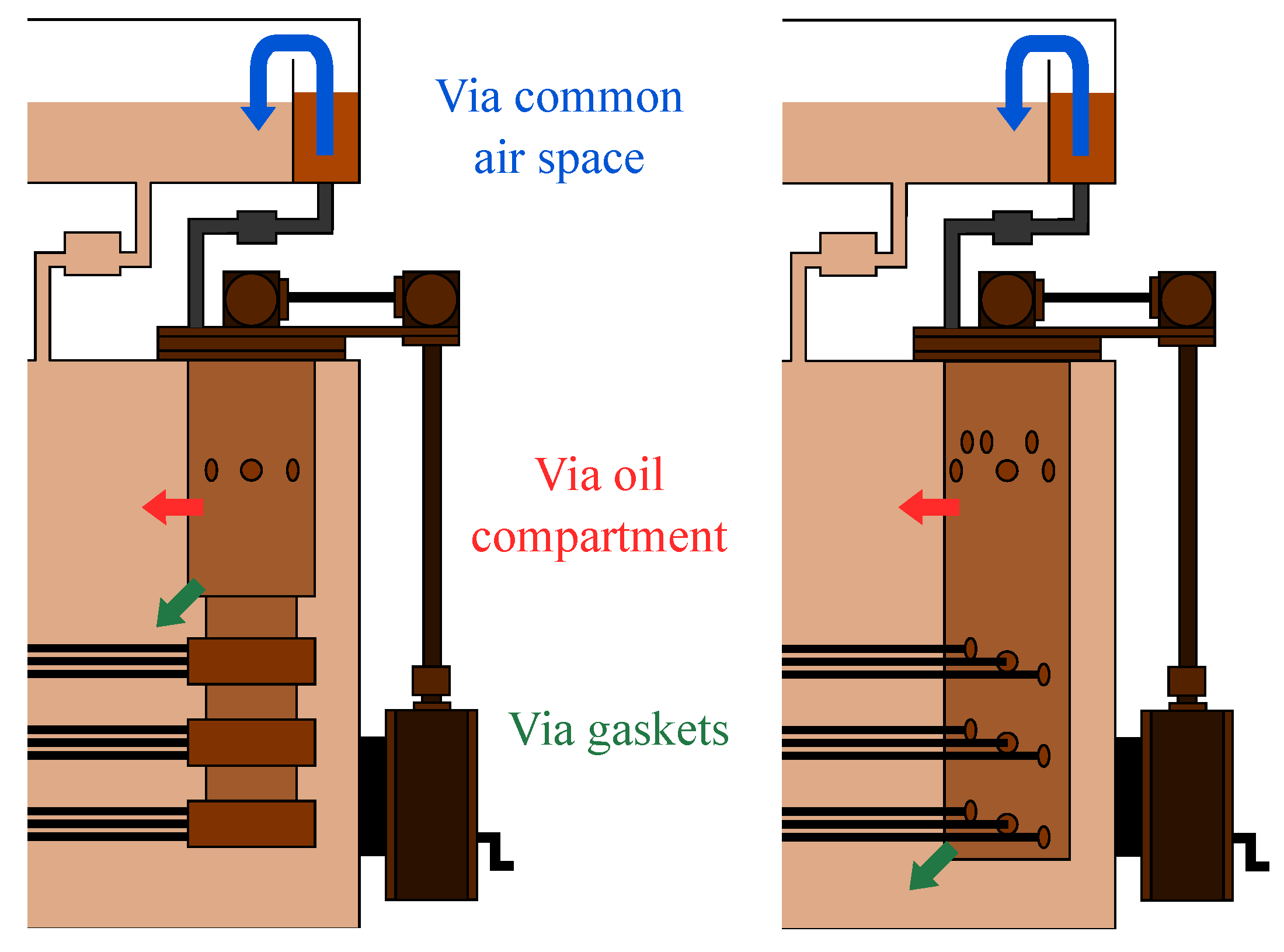

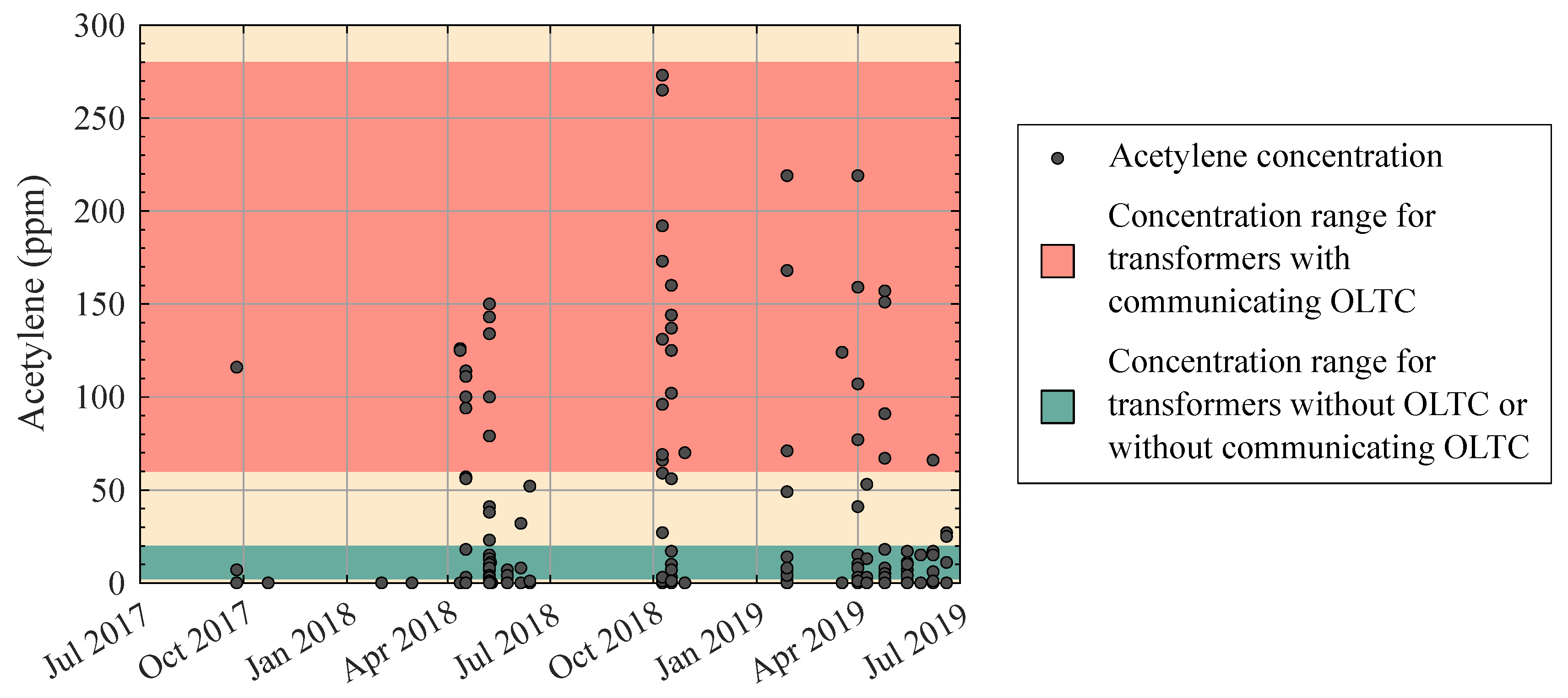

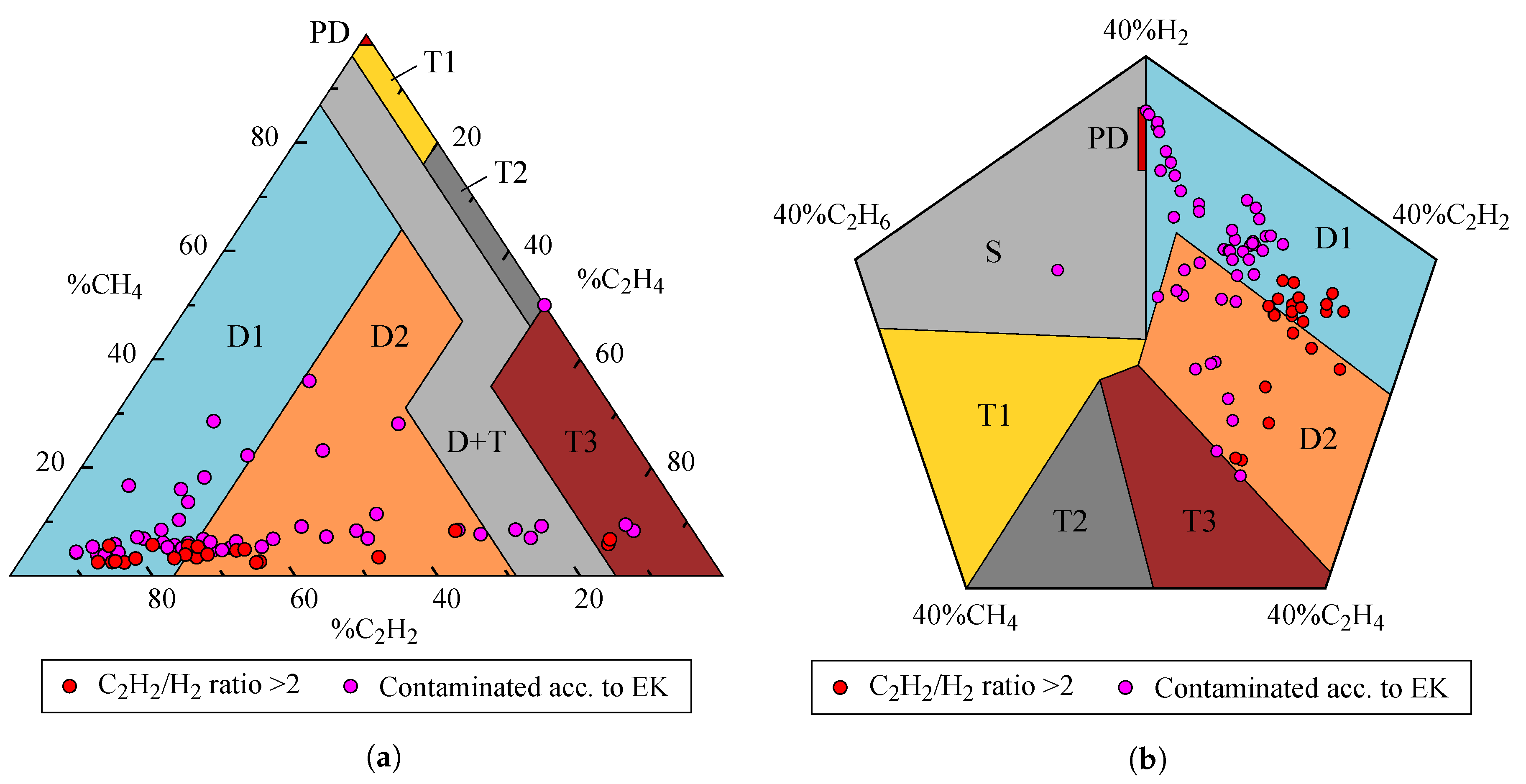
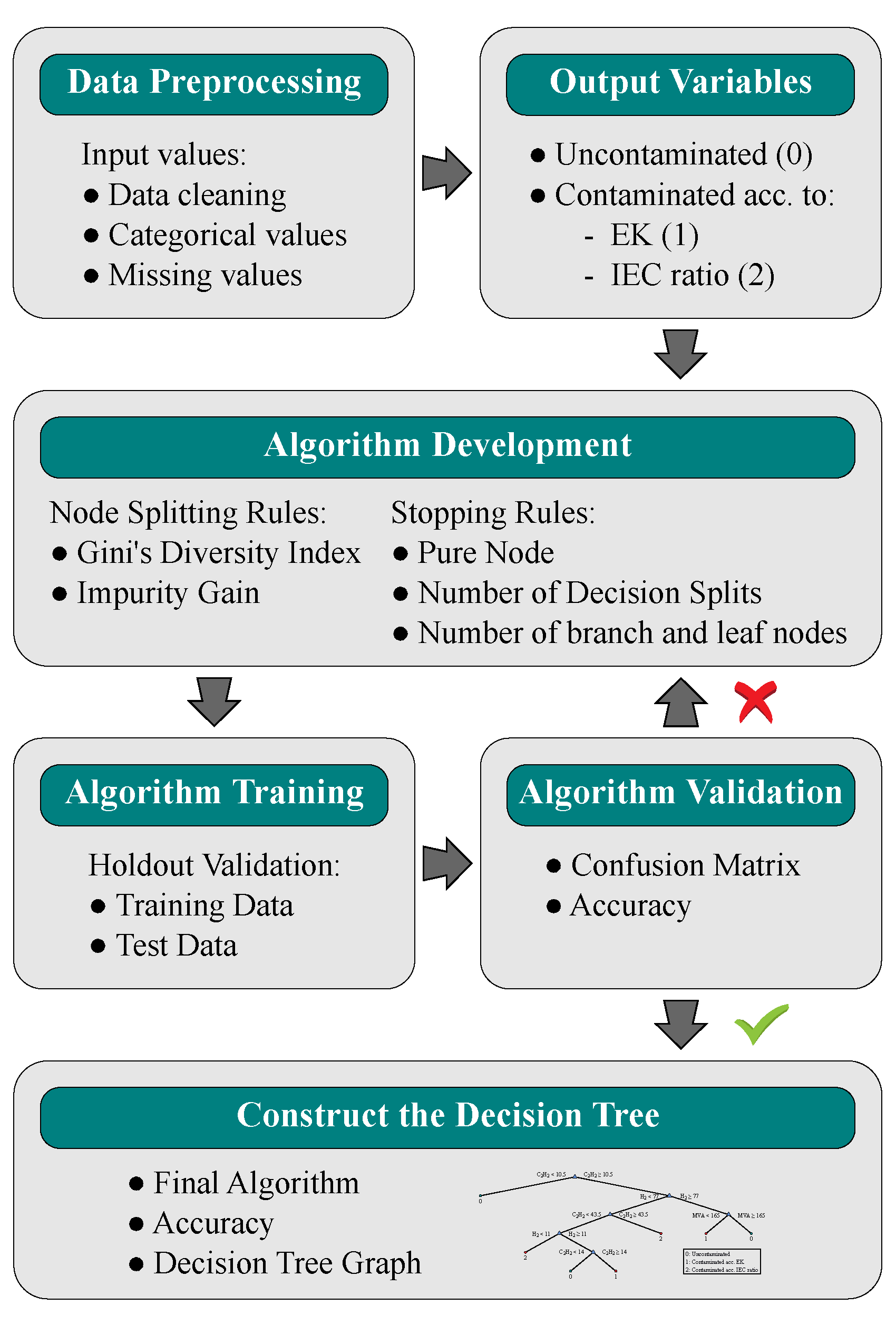
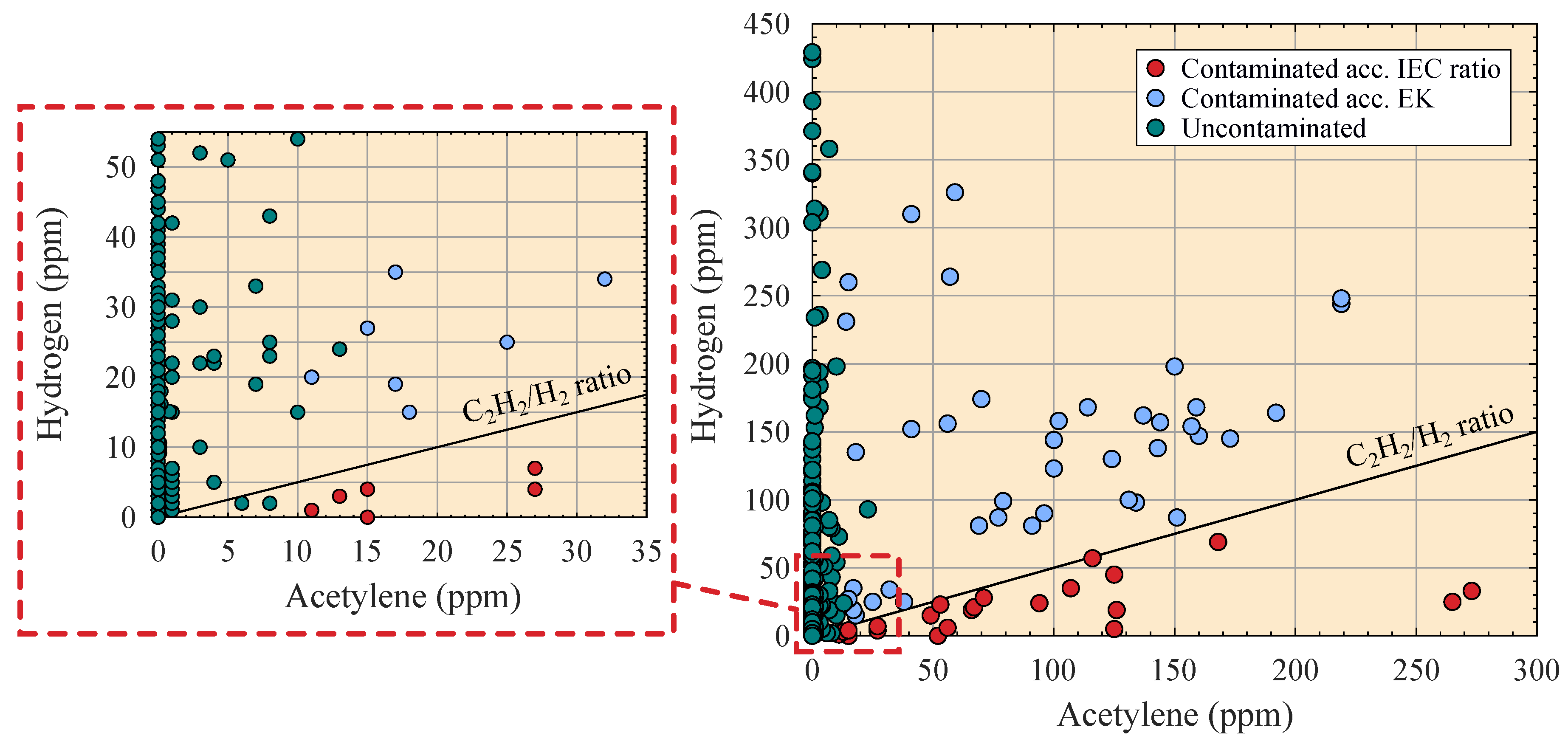

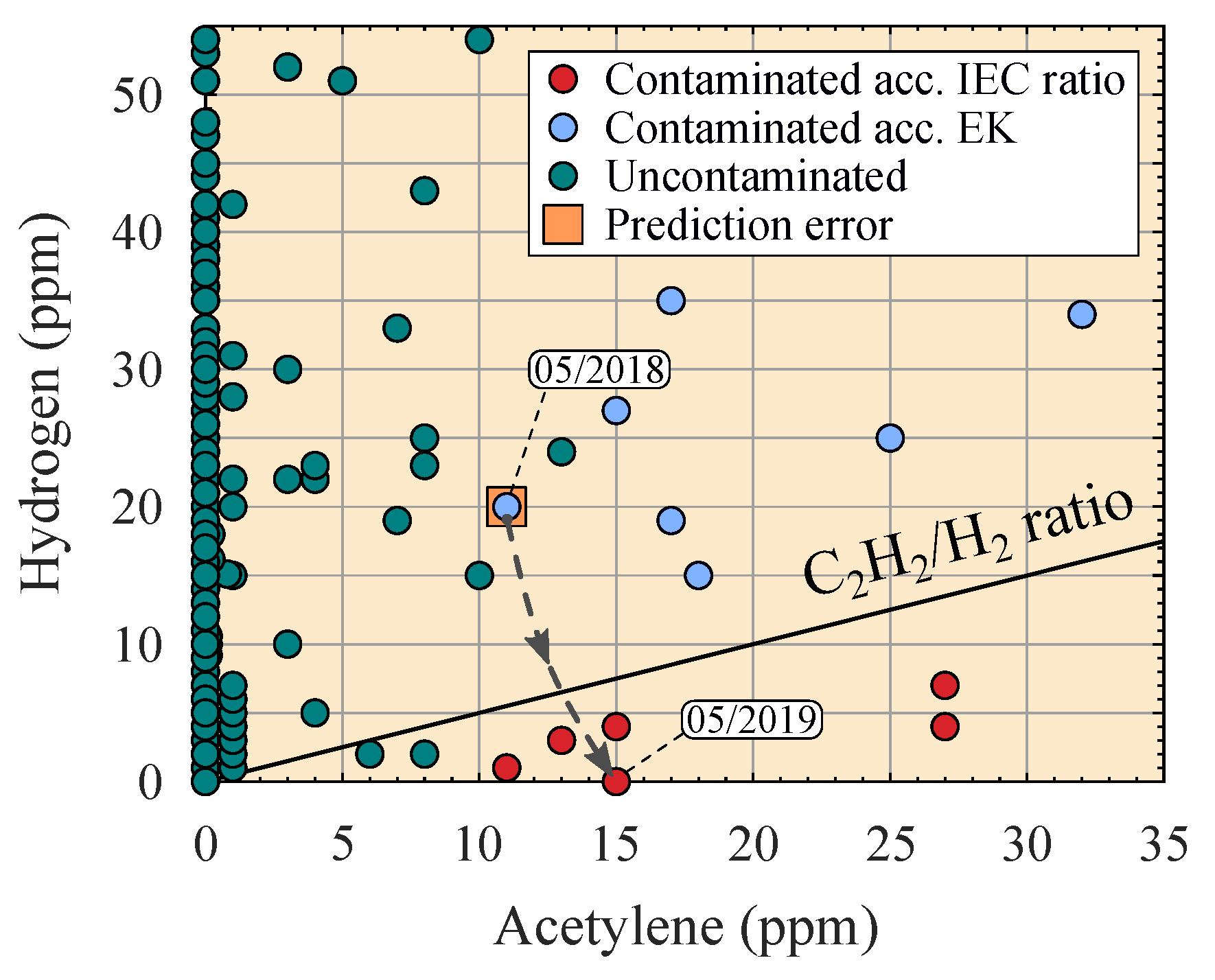
| Fault Type | Gas Generated | |||||
|---|---|---|---|---|---|---|
| H | CH | CH | CH | CH | ||
| Thermal faults in oil (<300 C) | T1 | ∘ | • | • | · | |
| Thermal faults in oil (300–700 C) | T2 | ∘ | ∘ | ∘ | • | · |
| Thermal faults in oil (>700 C) | T3 | ∘ | • | ∘ | ||
| Partial discharges | PD | • | ∘ | · | ||
| Low energy discharge—sparking | D1 | • | ∘ | • | ||
| High energy discharge—arcing | D2 | • | ∘ | • | ||
| IEEE [6] | IEC [7] | |||
|---|---|---|---|---|
| ON Ratio 0.2 | ON Ratio > 0.2 | No OLTC | Communicating OLTC | |
| 90th percentile | 1 | 2 | 2–20 | 60–280 |
| 95th percentile | 2 * | 7 | - | - |
| OLTC Components | Gas Sources |
|---|---|
| Arc-switching contacts | High energy discharge gases |
| Commutation contacts, by-pass contacts | Low energy discharge gases |
| Vacuum interrupters | No gases |
| Transition resistors | Heating gases 300 C (normal operation) Heating gases > 300 C (overload, fault case) |
| Transition reactance (preventive autotransformer, inside transformer tank) | No gases |
| Transformer No. | Sample Date | CH/H Ratio | Age (Years) | Acetylene (ppm) | Hydrogen (ppm) |
|---|---|---|---|---|---|
| 1 | 25/04/2019 | − | 54 | 0 | 0 |
| 2 | 24/05/2018 | − | 10 | 0 | 0 |
| 3 | 13/06/2018 | − | 44 | 52 | 0 |
| 4 | 27/05/2019 | − | 29 | 15 | 0 |
| 5 | 25/09/2017 | − | 26 | 0 | 0 |
| Transformer No. | Sample Date | CH/H Ratio | Age (Years) | Acetylene (ppm) | Hydrogen (ppm) |
|---|---|---|---|---|---|
| 3 | 17/10/2018 | 9.33 | 44 | 56 | 6 |
| 3 | 28/01/2019 | 3.27 | 44 | 49 | 15 |
| 3 | 09/04/2019 | 2.30 | 44 | 53 | 23 |
| 6 | 19/06/2019 | 6.75 | 30 | 27 | 4 |
| 7 | 28/01/2019 | 2.54 | 23 | 71 | 28 |
| 8 | 17/04/2018 | 3.92 | 20 | 94 | 24 |
| 8 | 28/01/2019 | 2.44 | 20 | 168 | 69 |
| 9 | 07/06/2019 | 3.47 | 18 | 66 | 19 |
| 10 | 01/04/2019 | 3.06 | 51 | 107 | 35 |
| 10 | 17/10/2018 | 2.78 | 51 | 125 | 45 |
| 11 | 25/09/2017 | 2.04 | 44 | 116 | 57 |
| 12 | 07/06/2019 | 3 | 44 | 6 | 2 |
| 13 | 28/01/2019 | 4 | 50 | 8 | 2 |
| 14 | 12/04/2018 | 25 | 34 | 125 | 5 |
| 14 | 09/10/2018 | 8.27 | 34 | 273 | 33 |
| 15 | 09/10/2018 | 10.60 | 34 | 265 | 25 |
| 15 | 12/04/2018 | 6.63 | 34 | 126 | 19 |
| 16 | 25/04/2019 | 3.19 | 28 | 67 | 21 |
| 17 | 08/05/2018 | 4.33 | 26 | 13 | 3 |
| 17 | 09/10/2018 | 3.86 | 26 | 27 | 7 |
| 17 | 07/06/2019 | 3.75 | 26 | 15 | 4 |
| 18 | 15/05/2019 | 11 | 45 | 11 | 1 |
| Transformer No. | Sample Date | CH/H Ratio | Age (Years) | Acetylene (ppm) | Hydrogen (ppm) |
|---|---|---|---|---|---|
| 4 | 09/05/2018 | 0.55 | 29 | 11 | 20 |
| 19 | 01/04/2019 | 0.88 | 48 | 219 | 248 |
| 19 | 17/10/2018 | 0.92 | 48 | 144 | 157 |
| 19 | 17/04/2018 | 0.68 | 48 | 114 | 168 |
| 20 | 28/01/2019 | 0.90 | 47 | 219 | 244 |
| 20 | 09/10/2018 | 1.17 | 47 | 192 | 164 |
| 20 | 08/05/2018 | 0.76 | 47 | 150 | 198 |
| 21 | 01/04/2019 | 0.95 | 50 | 159 | 168 |
| 21 | 17/10/2018 | 0.85 | 50 | 137 | 162 |
| 21 | 17/04/2018 | 0.69 | 50 | 100 | 144 |
| 22 | 25/04/2019 | 1.74 | 49 | 151 | 87 |
| 22 | 08/05/2018 | 1.37 | 49 | 134 | 98 |
| 22 | 09/10/2018 | 1.31 | 49 | 131 | 100 |
| 23 | 18/03/2019 | 0.95 | 45 | 124 | 130 |
| 23 | 08/05/2018 | 0.81 | 45 | 100 | 123 |
| 23 | 09/10/2018 | 1.07 | 45 | 96 | 90 |
| 24 | 17/10/2018 | 0.65 | 48 | 102 | 158 |
| 24 | 17/04/2018 | 0.36 | 48 | 56 | 156 |
| 25 | 25/04/2019 | 1.12 | 49 | 91 | 81 |
| 25 | 08/05/2018 | 0.80 | 49 | 79 | 99 |
| 25 | 09/10/2018 | 0.85 | 49 | 69 | 81 |
| 26 | 09/10/2018 | 0.18 | 18 | 59 | 326 |
| 26 | 17/04/2018 | 0.22 | 18 | 57 | 264 |
| 26 | 01/04/2019 | 0.13 | 18 | 41 | 310 |
| 27 | 05/06/2018 | 0.94 | 43 | 32 | 34 |
| 27 | 19/06/2019 | 1 | 43 | 25 | 25 |
| 28 | 08/05/2018 | 0.25 | 48 | 23 | 93 |
| 29 | 17/04/2018 | 0.13 | 18 | 18 | 135 |
| 29 | 15/05/2019 | 0.49 | 18 | 17 | 35 |
| 30 | 25/04/2019 | 1.20 | 32 | 18 | 15 |
| 31 | 01/04/2019 | 0.06 | 19 | 15 | 260 |
| 31 | 28/01/2019 | 0.06 | 19 | 14 | 231 |
| 32 | 07/06/2019 | 0.90 | 29 | 17 | 19 |
| 33 | 19/06/2019 | 0.15 | 23 | 11 | 73 |
| Run No. | Class | 90% Training and 10% Test | 80% Training and 20% Test | 70% Training and 30% Test | 60% Training and 40% Test | 50% Training and 50% Test | |||||||||||
|---|---|---|---|---|---|---|---|---|---|---|---|---|---|---|---|---|---|
| P | 0 | 1 | 2 | 0 | 1 | 2 | 0 | 1 | 2 | 0 | 1 | 2 | 0 | 1 | 2 | ||
| T | |||||||||||||||||
| 1 | 0 | 35 | 0 | 0 | 70 | 1 | 0 | 104 | 1 | 0 | 139 | 2 | 0 | 174 | 1 | 2 | |
| 1 | 0 | 4 | 0 | 0 | 8 | 0 | 0 | 10 | 2 | 0 | 14 | 3 | 0 | 18 | 2 | ||
| 2 | 0 | 0 | 2 | 0 | 0 | 4 | 0 | 3 | 4 | 0 | 2 | 6 | 0 | 4 | 7 | ||
| A (%): 100 | A (%): 98.80 | A (%): 95.16 | A (%): 95.78 | A (%): 95.67 | |||||||||||||
| 2 | 0 | 35 | 0 | 0 | 70 | 0 | 0 | 104 | 1 | 0 | 140 | 1 | 0 | 174 | 2 | 0 | |
| 1 | 0 | 4 | 0 | 0 | 8 | 0 | 0 | 13 | 0 | 1 | 16 | 0 | 0 | 18 | 3 | ||
| 2 | 0 | 0 | 2 | 0 | 0 | 5 | 0 | 3 | 3 | 0 | 2 | 6 | 0 | 2 | 9 | ||
| A (%): 100 | A (%): 100 | A (%): 96.77 | A (%): 97.59 | A (%): 96.63 | |||||||||||||
| 3 | 0 | 35 | 0 | 0 | 71 | 0 | 0 | 104 | 1 | 0 | 141 | 1 | 0 | 174 | 2 | 0 | |
| 1 | 0 | 4 | 0 | 0 | 8 | 0 | 0 | 12 | 0 | 0 | 13 | 3 | 3 | 14 | 4 | ||
| 2 | 0 | 0 | 2 | 0 | 0 | 4 | 0 | 0 | 7 | 0 | 2 | 6 | 0 | 1 | 10 | ||
| A (%): 100 | A (%): 100 | A (%): 99.19 | A (%): 96.39 | A (%): 95.19 | |||||||||||||
| 4 | 0 | 34 | 1 | 0 | 69 | 1 | 0 | 105 | 0 | 0 | 140 | 1 | 0 | 175 | 1 | 0 | |
| 1 | 0 | 4 | 0 | 0 | 8 | 0 | 0 | 13 | 0 | 0 | 16 | 0 | 0 | 20 | 0 | ||
| 2 | 0 | 0 | 2 | 0 | 0 | 5 | 0 | 0 | 6 | 0 | 3 | 6 | 1 | 4 | 7 | ||
| A (%): 97.56 | A (%): 98.80 | A (%): 100 | A (%): 97.59 | A (%): 97.11 | |||||||||||||
| 5 | 0 | 35 | 0 | 0 | 70 | 0 | 0 | 105 | 0 | 0 | 142 | 0 | 0 | 174 | 2 | 0 | |
| 1 | 0 | 4 | 0 | 0 | 8 | 0 | 1 | 11 | 1 | 1 | 15 | 0 | 0 | 21 | 0 | ||
| 2 | 0 | 0 | 2 | 0 | 0 | 5 | 1 | 1 | 4 | 1 | 2 | 5 | 0 | 4 | 7 | ||
| A (%): 100 | A (%): 100 | A (%): 96.77 | A (%): 97.59 | A (%): 97.11 | |||||||||||||
Publisher’s Note: MDPI stays neutral with regard to jurisdictional claims in published maps and institutional affiliations. |
© 2020 by the authors. Licensee MDPI, Basel, Switzerland. This article is an open access article distributed under the terms and conditions of the Creative Commons Attribution (CC BY) license (http://creativecommons.org/licenses/by/4.0/).
Share and Cite
Bustamante, S.; Manana, M.; Arroyo, A.; Laso, A.; Martinez, R. Determination of Transformer Oil Contamination from the OLTC Gases in the Power Transformers of a Distribution System Operator. Appl. Sci. 2020, 10, 8897. https://doi.org/10.3390/app10248897
Bustamante S, Manana M, Arroyo A, Laso A, Martinez R. Determination of Transformer Oil Contamination from the OLTC Gases in the Power Transformers of a Distribution System Operator. Applied Sciences. 2020; 10(24):8897. https://doi.org/10.3390/app10248897
Chicago/Turabian StyleBustamante, Sergio, Mario Manana, Alberto Arroyo, Alberto Laso, and Raquel Martinez. 2020. "Determination of Transformer Oil Contamination from the OLTC Gases in the Power Transformers of a Distribution System Operator" Applied Sciences 10, no. 24: 8897. https://doi.org/10.3390/app10248897
APA StyleBustamante, S., Manana, M., Arroyo, A., Laso, A., & Martinez, R. (2020). Determination of Transformer Oil Contamination from the OLTC Gases in the Power Transformers of a Distribution System Operator. Applied Sciences, 10(24), 8897. https://doi.org/10.3390/app10248897







